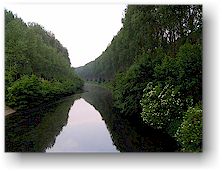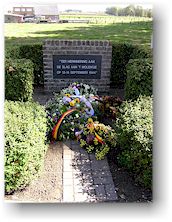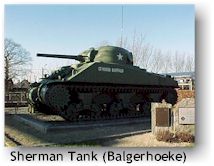|
  THE
BATTLE FOR "het Molentje" THE
BATTLE FOR "het Molentje"
"Het Molentje" is a quarter of
Moerkerke, situated on the northside of the
Leopold- and Schipdonkcanal. In this peaceful hamlet, the bloodiest battle
in Moerkerke's history took place and
this happened not so long ago. In September 1944, to be precise...
 The
plan. Since the landing in Normandy, the allied troops
advanced very rapidly in the direction of Germany. A large part
of Belgium had been liberated in the meanwhile. On 13 September
1944, Canadian infanterists would cross the Leopold- and
Schipdonkcanal in the area around "Het Molentje" and securing
this area. In the night of 13 to 14 September, engineers would
construct a steel bridge over the canals. This would enable the
allied tanks to penetrate the enemy lines and rapidly reach the
port of Breskens and free the left banks of the Schelde estuary.
This operation was necessary for the allied forces to enable
them to use the port of Antwerp for the supply of material and
stocks. With German soldiers still on the banks of the North
Sea and the Schelde, this was impossible till that time. The
mission was to be rounded off in just a few days. The
plan. Since the landing in Normandy, the allied troops
advanced very rapidly in the direction of Germany. A large part
of Belgium had been liberated in the meanwhile. On 13 September
1944, Canadian infanterists would cross the Leopold- and
Schipdonkcanal in the area around "Het Molentje" and securing
this area. In the night of 13 to 14 September, engineers would
construct a steel bridge over the canals. This would enable the
allied tanks to penetrate the enemy lines and rapidly reach the
port of Breskens and free the left banks of the Schelde estuary.
This operation was necessary for the allied forces to enable
them to use the port of Antwerp for the supply of material and
stocks. With German soldiers still on the banks of the North
Sea and the Schelde, this was impossible till that time. The
mission was to be rounded off in just a few days.
The order.
Straight from Adolf Hitler's headquarters came the order to
stand ground at all cost alongside the Leopoldcanal that was to
be strengthened. This order was carried out scrupulously.
Reinforcements were brought in, 20mm canons, antitank weapons
and grenade launchers were put in position, sharpshooters' holes
and machinegun nests were dug out. The Wehrmacht had made all
the necessary arrangements to receive the rapidly approaching
Canadian liberators...
Prelude. In the morning of
10 September the bridges over the canals are blown up by the Germans, shortly
after which the sleuces are opened and slowly the meadows inundate. To avoid
that the church of Moerkerke could be used by the allies as an observation post,
on 12 September (at 14h30) the tower is shot down by
German Flak artillery,
placed on the other side of the canals. 9 grenades suffice. Shortly after that,
the Canadian arrival is announced by the shaking noise of armored vehicles
coming from the direction of Vivenkapelle. Allied tanks shoot the mill of "Schuts"
on fire, thinking that the Germans use the mill as an outpost. Tanks roll into
the center of the village. Moerkerke is liberated.
 The
battle. The day is Wednesday 13 September. The first shots
fall. Grenades are being fired from heavy field artillery
batteries along the two sides. The Canadian ones are around
Sijsele; the German ones on the North Sea coast. The evening
falls and assaultboats are being put in the water; a total of
440 Canadian infanteriy soldiers cross the canals. 360 of them
have to secure the bridgehead. In the meanwhile, at a few
hundred meters from the canals, the bridge lies ready to be
assembled. The tanks are ready to go and are stationed just
outside the village. The middle dike is relatively easily
captured. Once the infanterists cross the second canal, things
start to go wrong. The liberators encounter an unexpected
strong German defence. Errors in orientation and the falling
out of the radiocontact isolate small groups of Canadian
soldiers. At the same time, Germans close in on the Canadians.
All ends up in terrifying house-to-house, even man-to-man fights.
Civilians, which are not evacuated, undergo the killing, hiding
in the basements of their houses. The Canadians try to hold the
bridgehead during 17 long hours. Persistent German artillery
and machinegun fire make it impossible to even attempt the
assembly of the bridge. The liberators are running out of
amunition, fights continue with knives, bayonets and captured
weapons... The Canadians find themselves in a hopeless
situation and have to retreat. The Germans successfully
executed their order. Liberators never succeeded in liberating
the rest of Belgium via this place. The
battle. The day is Wednesday 13 September. The first shots
fall. Grenades are being fired from heavy field artillery
batteries along the two sides. The Canadian ones are around
Sijsele; the German ones on the North Sea coast. The evening
falls and assaultboats are being put in the water; a total of
440 Canadian infanteriy soldiers cross the canals. 360 of them
have to secure the bridgehead. In the meanwhile, at a few
hundred meters from the canals, the bridge lies ready to be
assembled. The tanks are ready to go and are stationed just
outside the village. The middle dike is relatively easily
captured. Once the infanterists cross the second canal, things
start to go wrong. The liberators encounter an unexpected
strong German defence. Errors in orientation and the falling
out of the radiocontact isolate small groups of Canadian
soldiers. At the same time, Germans close in on the Canadians.
All ends up in terrifying house-to-house, even man-to-man fights.
Civilians, which are not evacuated, undergo the killing, hiding
in the basements of their houses. The Canadians try to hold the
bridgehead during 17 long hours. Persistent German artillery
and machinegun fire make it impossible to even attempt the
assembly of the bridge. The liberators are running out of
amunition, fights continue with knives, bayonets and captured
weapons... The Canadians find themselves in a hopeless
situation and have to retreat. The Germans successfully
executed their order. Liberators never succeeded in liberating
the rest of Belgium via this place.
CLICK HERE FOR THE
MAP OF THE BATTLEFIELD
 After
the battle. The Canadians tried it again a bit further to
the east: between Strobrugge (on the road Maldegem-Aardenburg)
and Moershoofde. This was the beginning of what was called
operation "Switchback". The attack began on 6 October and only
from 19 October their position was secured so that the advance
to Breskens could finally be continued. Around 19 October, the
zone around "Het Molentje" cleared and the German lines were
pulled back to the "Damse Vaart", where German soldiers in the
evening of 22 October blew up the
church tower of Oostkerke
with 2500 kg of dynamite. The region north of the Leopoldcanal
remained occupied for another 6 weeks after the battle of "Het
Molentje". Only on 3 November, the liberation was a fact. After
the battle. The Canadians tried it again a bit further to
the east: between Strobrugge (on the road Maldegem-Aardenburg)
and Moershoofde. This was the beginning of what was called
operation "Switchback". The attack began on 6 October and only
from 19 October their position was secured so that the advance
to Breskens could finally be continued. Around 19 October, the
zone around "Het Molentje" cleared and the German lines were
pulled back to the "Damse Vaart", where German soldiers in the
evening of 22 October blew up the
church tower of Oostkerke
with 2500 kg of dynamite. The region north of the Leopoldcanal
remained occupied for another 6 weeks after the battle of "Het
Molentje". Only on 3 November, the liberation was a fact.
On "Het Molentje" a
modest
monument has been placed in memory of the tragic events that
took place here in the night of 13 to 14 September 1944, when a
lot of soldiers (German and Canadian), but also civilians were
killed. May this never happen again... A street in Moerkerke
has been named to the Canadian regiment that fought here: the
Algonquinstraat.
Related subjects: Canadamuseum
and Canadian War Cemetary in Adegem (see
Adegem) |

 The
plan. Since the landing in Normandy, the allied troops
advanced very rapidly in the direction of Germany. A large part
of Belgium had been liberated in the meanwhile. On 13 September
1944, Canadian infanterists would cross the Leopold- and
Schipdonkcanal in the area around "Het Molentje" and securing
this area. In the night of 13 to 14 September, engineers would
construct a steel bridge over the canals. This would enable the
allied tanks to penetrate the enemy lines and rapidly reach the
port of Breskens and free the left banks of the Schelde estuary.
This operation was necessary for the allied forces to enable
them to use the port of Antwerp for the supply of material and
stocks. With German soldiers still on the banks of the North
Sea and the Schelde, this was impossible till that time. The
mission was to be rounded off in just a few days.
The
plan. Since the landing in Normandy, the allied troops
advanced very rapidly in the direction of Germany. A large part
of Belgium had been liberated in the meanwhile. On 13 September
1944, Canadian infanterists would cross the Leopold- and
Schipdonkcanal in the area around "Het Molentje" and securing
this area. In the night of 13 to 14 September, engineers would
construct a steel bridge over the canals. This would enable the
allied tanks to penetrate the enemy lines and rapidly reach the
port of Breskens and free the left banks of the Schelde estuary.
This operation was necessary for the allied forces to enable
them to use the port of Antwerp for the supply of material and
stocks. With German soldiers still on the banks of the North
Sea and the Schelde, this was impossible till that time. The
mission was to be rounded off in just a few days. The
battle. The day is Wednesday 13 September. The first shots
fall. Grenades are being fired from heavy field artillery
batteries along the two sides. The Canadian ones are around
Sijsele; the German ones on the North Sea coast. The evening
falls and assaultboats are being put in the water; a total of
440 Canadian infanteriy soldiers cross the canals. 360 of them
have to secure the bridgehead. In the meanwhile, at a few
hundred meters from the canals, the bridge lies ready to be
assembled. The tanks are ready to go and are stationed just
outside the village. The middle dike is relatively easily
captured. Once the infanterists cross the second canal, things
start to go wrong. The liberators encounter an unexpected
strong German defence. Errors in orientation and the falling
out of the radiocontact isolate small groups of Canadian
soldiers. At the same time, Germans close in on the Canadians.
All ends up in terrifying house-to-house, even man-to-man fights.
Civilians, which are not evacuated, undergo the killing, hiding
in the basements of their houses. The Canadians try to hold the
bridgehead during 17 long hours. Persistent German artillery
and machinegun fire make it impossible to even attempt the
assembly of the bridge. The liberators are running out of
amunition, fights continue with knives, bayonets and captured
weapons... The Canadians find themselves in a hopeless
situation and have to retreat. The Germans successfully
executed their order. Liberators never succeeded in liberating
the rest of Belgium via this place.
The
battle. The day is Wednesday 13 September. The first shots
fall. Grenades are being fired from heavy field artillery
batteries along the two sides. The Canadian ones are around
Sijsele; the German ones on the North Sea coast. The evening
falls and assaultboats are being put in the water; a total of
440 Canadian infanteriy soldiers cross the canals. 360 of them
have to secure the bridgehead. In the meanwhile, at a few
hundred meters from the canals, the bridge lies ready to be
assembled. The tanks are ready to go and are stationed just
outside the village. The middle dike is relatively easily
captured. Once the infanterists cross the second canal, things
start to go wrong. The liberators encounter an unexpected
strong German defence. Errors in orientation and the falling
out of the radiocontact isolate small groups of Canadian
soldiers. At the same time, Germans close in on the Canadians.
All ends up in terrifying house-to-house, even man-to-man fights.
Civilians, which are not evacuated, undergo the killing, hiding
in the basements of their houses. The Canadians try to hold the
bridgehead during 17 long hours. Persistent German artillery
and machinegun fire make it impossible to even attempt the
assembly of the bridge. The liberators are running out of
amunition, fights continue with knives, bayonets and captured
weapons... The Canadians find themselves in a hopeless
situation and have to retreat. The Germans successfully
executed their order. Liberators never succeeded in liberating
the rest of Belgium via this place. After
the battle. The Canadians tried it again a bit further to
the east: between Strobrugge (on the road Maldegem-Aardenburg)
and Moershoofde. This was the beginning of what was called
operation "Switchback". The attack began on 6 October and only
from 19 October their position was secured so that the advance
to Breskens could finally be continued. Around 19 October, the
zone around "Het Molentje" cleared and the German lines were
pulled back to the "Damse Vaart", where German soldiers in the
evening of 22 October blew up the
After
the battle. The Canadians tried it again a bit further to
the east: between Strobrugge (on the road Maldegem-Aardenburg)
and Moershoofde. This was the beginning of what was called
operation "Switchback". The attack began on 6 October and only
from 19 October their position was secured so that the advance
to Breskens could finally be continued. Around 19 October, the
zone around "Het Molentje" cleared and the German lines were
pulled back to the "Damse Vaart", where German soldiers in the
evening of 22 October blew up the
